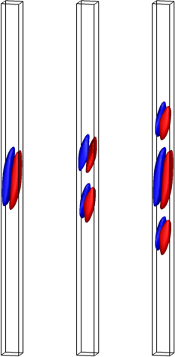Cédric Beaume
Applied Mathematician
You are in Research > Coupled convection
Coupled convection
In general, doubly diffusive convection refers to situations in which fluid motion is driven by two diffusing fields, one of which is temperature. A classic illustration of this is thermosolutal convection in which a binary fluid is placed within gradients of temperature and concentration. When these gradients provide competing contributions to the buoyancy, a very rich configuration arises. This occurs in many natural situations such as in oceans where salinity and temperature vary, or in industrial applications such as in mixing processes where the concentration of both components diffuses as the mixture is cooled down. Doubly diffusive convection is known to exhibit stationary convection, traveling/standing waves as well as chaotic regimes.
Vertically stratified doubly diffusive convection
In binary fluid layers heated from below and where the lightest component overlies the heaviest one, stationary convection takes the form of a periodic array of counterrotating rolls. In specific ranges of the parameters, solutions can be found to be convective in a specific spatial region while being conductive elsewhere. These solutions characterized by only a few rolls surrounded by motionless fluid are referred to as convectons (figure 1). They are found to lie on snaking branches (cf spatial localization) implying that a large number of spatially localized solutions of different size and type coexist. Although these stationary structures are unstable, it is found that spatially localized solutions are found to be easily observable in time-dependent regimes (cf Beaume et al., Phys. Fluids (2011)).

Figure 1: Convectons represented by isovalues of the streamfunction. Red: clockwise motion, blue: anti-clockwise motion.
Horizontally stratified doubly diffusive convection
Binary fluids placed within horizontal gradients of temperature and concentration can also produce interesting behaviors when the thermal and solutal effects are competing and involve diffusion at different rates. Within this framework, stationary convection takes the form of co-rotating rolls aligned in the vertical direction, one sense of rotation being favored over the other due to the difference in diffusion rates. Much as for vertically stratified fluids, this configuration gives rise to spatially localized convection states. Several types of these structures have been found (figure 2). The simplest one gathers structures where all the rolls have the same axis and a variant of this type consists in twisted rolls, i.e. rolls which have different horizontal axes. Bound states of regular and twisted rolls can also be found. Both of these structures produce snaking (cf spatial localization) and therefore provide coexistence of a large number of solutions. In addition to these stationary structures, this system exhibits chaos very close to onset and the resulting regime commonly shows spatial localization and twisting (cf Beaume et al., Phys. Fluids (2013a)). Finally, considering domains with a long extent in the direction of the roll axis, localized solutions of arbitrary length can be found (figure 3). These solutions lie on a vertical branch as one follows them against one parameter, providing a continuum of coexisting localized solutions (cf spatial localization and Beaume et al., Phys. Fluids (2013b)). |
 Figure 2: Convectons represented by two opposite values of the vertical velocity. Red: upward flow, blue: downward flow. |

Figure 3: Convecton represented by two opposite values of the horizontal velocity in the cross-section. Red: out-of-the-screen flow, blue: into-the-screen flow.
Sources:
-
Nonsnaking doubly diffusive convectons and the twist instability,
C. Beaume, E. Knobloch & A. Bergeon, Phys. Fluids 25, 114102 (2013b) -
Convectons and secondary snaking in three-dimensional natural doubly diffusive convection,
C. Beaume, A. Bergeon & E. Knobloch, Phys. Fluids 25, 024105 (2013a) -
Homoclinic snaking of localized states in doubly diffusive convection,
C. Beaume, A. Bergeon & E. Knobloch, Phys. Fluids 23, 094102 (2011)


